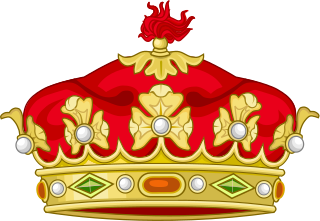 W
WBaron of Santa Pau is a hereditary title in the Peerage of Spain created in Catalonia on an unknown date, though believed to have been made before 1070, as at that time, in Girona, there are records of a knight named Almérico I de Santa Pau as the lord of this barony, being the first person recorded as such. After that, the title is lost, until it is once again mentioned in 1360, without mention of who the baron was.
 W
WThe Barony of Polop and Benidorm is an ancient Spanish hereditary lordship in the Kingdom of Valencia under the Crown of Aragon. The barony, including the castles of Polop and Benidorm and extensive land, is located in the province of Alicante, Valencia, Spain, only a few miles from the Mediterranean Sea.
 W
WCount of Echauz is a Spanish hereditary peerage title which was created by King Charles III of Spain and Naples in 1784 and bestowed upon José Manuel de Acedo y Jiménez de Loyola, heir of the Majorat of Loyola, Acedo and Lord of Riocavado.
 W
WCount of Mayalde is a noble title created in 1596 by King Philip II of Spain for Juan de Borja y Castro son of Saint Francis Borgia, 1st Marquis of Lombay.
 W
WThe County of Trastámara was a tenancy of the crown in the Kingdom of Galicia in the Middle Ages. Its name comes from the Latin tra(n)s Tamar(is), meaning "beyond [north of] the Tambre", a river which runs through Galicia. It was regularly granted to men of a single family, the House of Traba from the 11th century into the 13th, after which it was often given for life to others, including Alvar Núñez Osorio and the future King Henry II of Castile, whose dynasty is thus known as the House of Trastámara. On 4 February 1445 in San Martín de Valdeiglesias, it was granted as a hereditary possession to Pedro Álvarez Osorio by Juan II of Castile.
 W
WThe County of Guadalupe del Peñasco is a title of Spanish nobility granted by King Charles III of Spain to Don Francisco Javier de Mora y Luna, Colonel of Dragons of the provincial militias on 26 January 1768.
 W
WDuke of Sueca is a title of Spanish nobility, Grandee of Spain 1st class. It was created by King Charles IV of Spain in 1804 for Manuel Godoy, who was the Prime Minister of Spain from 1792 to 1797 and from 1801 to 1808. Its name refers to Sueca in the Province of Valencia in Spain.
 W
WDuke of Fernán Núñez is a hereditary title of nobility in the Peerage of Spain accompanied by the dignity of Grandee. The Countship of Fernán Núñez granted in 1639 to Alonso Gutiérrez de los Ríos was elevated to a dukedom in 1817 in the person of Carlos José Gutiérrez de los Ríos, who became the 1st Duke of Fernán Núñez.
 W
WAn hidalgo or a fidalgo is a member of the Spanish or Portuguese nobility; the feminine forms of the terms are hidalga, in Spanish, and fidalga, in Portuguese and Galician. In popular usage, the term hidalgo identifies a nobleman without a hereditary title. In practice, hidalgos were exempted from paying taxes, yet owned little real property.
 W
WLatas [pronunciation: 'la tas ] is a noble historic family infanzona Aragonese that was first documented as Latas or Lata in 1055 a.C. The family comes from the mountains of the primitive Kingdom of Aragon, in the northern half of the current Spanish province of Huesca.
 W
WThis is a list of the 168 present and extant barons in the peerage of the Kingdom of Spain.
 W
WThis is a list of the 141 present and extant viscounts in the peerage of the Kingdom of Spain.
 W
WMarquess of Castelldosrius is a hereditary title in the Peerage of Spain, accompanied by the dignity Grandee and granted on 6 April 1696 by Charles II to Manuel de Oms y Santa Pau, knight of the Order of Malta, governor of Tarragona, viceroy and captain general of Mallorca, of Peru, of Tierra Firme and of Chile. The grandeeship was merged into the marquessate on 9 July 1701 by Philip V, later confirmed on 1 May 1703.
 W
WMarquess of San Isidro was a hereditary title in the Peerage of Spain, granted in 1730 by Philip V to Pablo Rui-Gómez, Viscount of Benafarces, knight of the Order of Santiago and perpetual regidor of León. The title was granted in recognition of his contribution to the restoration of the Basilica of San Isidoro in Leon, Spain.
 W
WMarquess of Silvela is a hereditary title of nobility in the Peerage of Spain accompanied by the dignity of Grandee. It was bestowed by Alfonso XIII on Amalia Loring, in memory of his late husband, Francisco Silvela, who was Prime Minister of Spain.
 W
WCount of Teba is a hereditary title in the Peerage of Spain, granted in 1522 by Charles I to Diego Ramírez de Guzmán, son of the 1st Lord of Teba. The name makes reference to the municipality of Teba, in Málaga, Spain.